To really get to know Andalucia it’s often best to head away from the crowds and instead seek out the quiet solace of village life. This is the perfect accompaniment to a relaxing villa break here in Spain.
In “Los Pueblos Blancos” you can escape the daily grind, and take a step back in time to a place where gentle fountains animate quaint town squares, and the slow pace of life is often interrupted only by children kicking around a ball, or by the town’s old folk enjoying animated debates at their favourite bench.
When you choose to spend a villa holiday on the Costa del Sol you can find a surprising number of charming sleepy villages within easy reach, just waiting to be explored. Here is a quick run through of some of our favourite white villages in Andalucia:
Casares
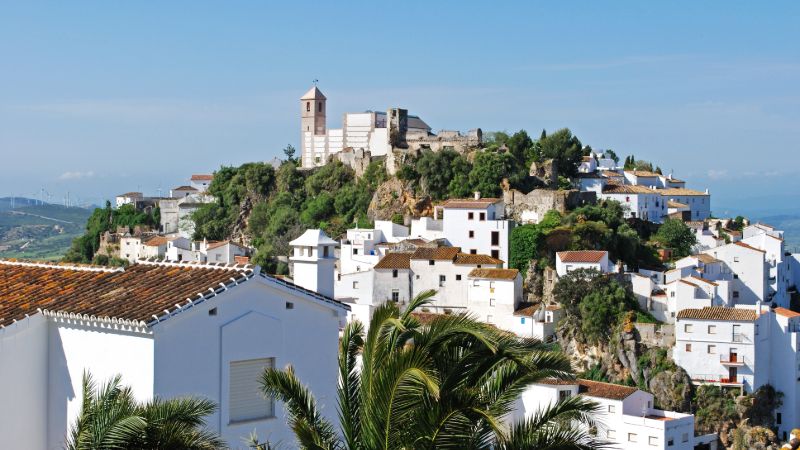
Casares is fifteen kilometres inland of Estepona, to the west of Marbella, in Malaga province of Andalucía. It is perched on the side of a mountain close to the Sierra Crestellina national park, approximately a twenty five minute drive from Estepona.
It is a breathtaking village which has been described as ‘sugar cubes’ on the side of the mountain and looks particularly stunning when lit up at night with the blue/green street lights. The best view is from the approach into Casares so be sure to take the time to stop and take in the sights before you get there.
Casares has a spectacular 12th century Moorish castle, several churches and chapels, each one as beautiful as the previous one, a visitor centre, fountain and is close to the Baths of La Hedionda which are Roman baths and sulphur springs said to have been used to cure a skin infection of Julius Caesar! It is known as the ‘Hanging Village’ due to its precarious location on the Cliffside. There are many great restaurants and tapas bars and lots of village shops to explore, if you are lucky you will see some eagles soaring above the cliffs around Casares.
As well as the national festivals such as of Andalucía day on the 28th of February, the Easter festivities and the Three Kings parades on the evening of the 5th of January, Casares has its annual feria in the second half of July and a second feria in the first week of August so it’s a great time to visit around then.
Frigiliana
Frigiliana is to the east of Malaga and only a ten minute drive from the coastal town of Nerja in the area of Andalucía known as the Axarquia.
Voted most beautiful village in Andalucía for several years running, the village’s cobbled streets gently wind up through the beautifully maintained white houses of the old town, splashes of colour wherever you look from the balconies and doorsteps full of beautifully kept flowers. The houses are painted every year and it is traditionally the women of the village who carry out this work.
Frigiliana has a great infrastructure including many shops, bars and fabulous restaurants, several hotels and a working molasses factory right in the centre of town. The streets are hilly here and there are beautiful mosaic covered steps leading to the tiny narrow residential streets from the main road.
The very famous Frigiliana festival, Festival de las Tres Culturas, is celebrated at the end of August each year, drawing crowds of hundreds to watch the fabulous concerts and many other festivities. There are also other fiestas throughout the year including Saint Sebastian day in January, the patron saint of Frigiliana. The day of the cross is in May each year and the annual Frigiliana feria is in June.
Gaucin
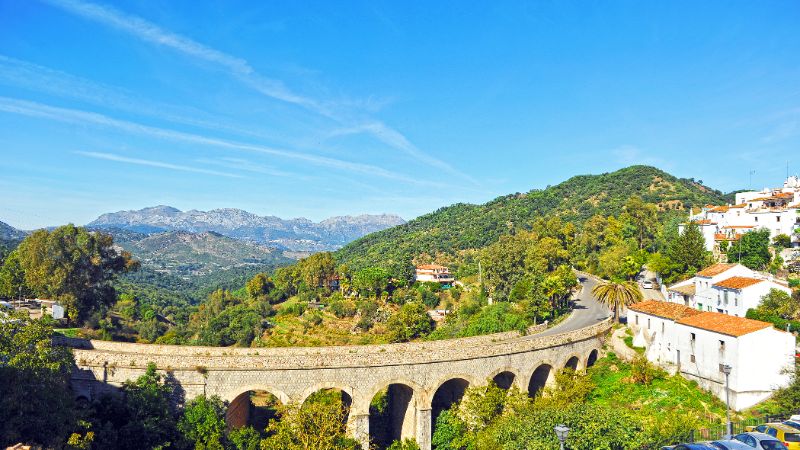
North of Casares, also to the west of Marbella, in the Malaga province of of Andalucía, is the white village of Gaucin. It is approximately nineteen km from Casares and a thirty minute drive from the coast.
Gaucin is around 600 metres above sea level in the Sierra del Hacho and has great views over Gibraltar and Morocco. It is surrounded by cork forests and because of this the local shops sell many items made from cork to tourists. The surrounding mountains provide a fabulous backdrop to the pretty white village, with contrasting colour from the wild poppies, orchids, olive groves and almond blossom.
At the very top of the village is a medieval castle, Castillo del Aguila or Eagle’s castle, where you can see eagles over the mountains as the name suggests. It is a sleepy, laid back town with a few similarly laid back bars and restaurants serving the traditional fayre of the area. The narrow winding streets of Gaucin have always been an inspiration for artists and photographers and there is a large artistic community here.
Among the many festivals of Gaucin, of particular note are the release of two bulls on Easter Sunday which are left to run around the village and chased by the more adventurous or crazy villagers. The annual feria is in August, around the fourth, and involves three days of live music, eating, drinking and dancing.
Iznajar
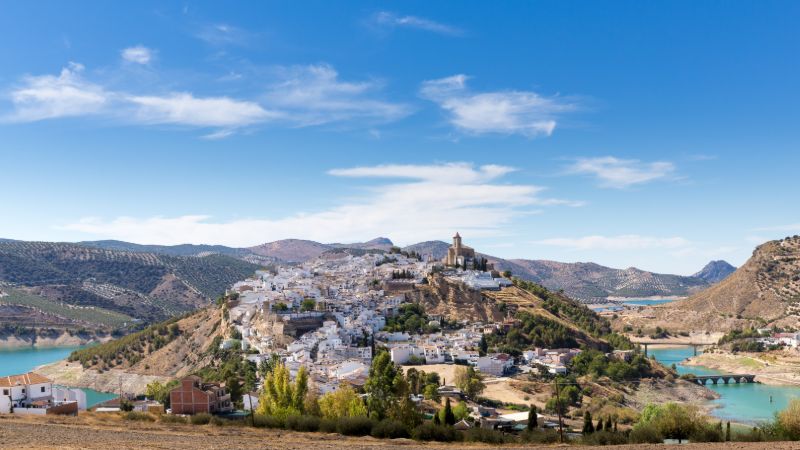
Located north of the Costa del Sol in the Cordoba province of Andalucía is the beautiful town of Iznajar. It is around one hour drive from Malaga and one hour from Granada.
Iznajar has a unique location overlooking the Embalse de Iznajar which is the largest lake in of Andalucía and has a lovely clean, sandy beach which is very popular in the summer months with whole families arriving in their cars, driving straight onto the beach, unpacking gazebos and tables and spending the day there swimming, sunbathing and eating. The village is nestled on a rocky outcrop with amazing views of the lake below. It is dominated by a majestic Moorish castle which is sadly in ruins but is lovely to walk to and the views from there are spectacular.
The village offers bars, restaurants and a lakeside hotel as well as a municipal museum. On the lake you can go fishing, learn to sail and you can rent out pedalos and kayaks from the campsite right on the beach. The lake is clean and safe to swim in and there are several beach bars to shelter from the sun in the hot afternoons.
The local festivals of Iznajar include a fabulous carnival, with parades and dressing up, in February. The patron saint of Iznajar, San Marco, has a special day on the 25th of April where the whole town heads off for picnics in the countryside. The feria is around the 7th of September every year and usually lasts for three days and includes a candlelight procession through the town.
Jimena
Jimena de la Frontera is in the province of Cadiz in Andalucía, it is about a thirty minute drive west of Gaucin and directly north of La Linea and the border of Gibraltar.
The village is surrounded by the Alcornocales Natural Park and is overlooked by a Moorish castle which was built around 750 A.D. It has been occupied since prehistoric times and here you can see cave paintings, at the archaeological site of La Laja Alta, which are the only examples of maritime cave paintings from the Bronze Age in Spain.
Transport links make Jimena easily accessible from all directions and the road and rail network is much improved in recent years. There are several beautiful churches and other buildings to visit. Other activities in the area include bike riding, horse riding and hill walking due to the proximity of the beautiful Natural Park.
As well as the national festivals of Spain, Jimena has several of its own throughout the year. The Carnival with parades of floats is in February, the agricultural fair is in the second week of May every year. There is an annual music festival in the second week of July and the Jimena feria is generally in the first week of September.
Mijas
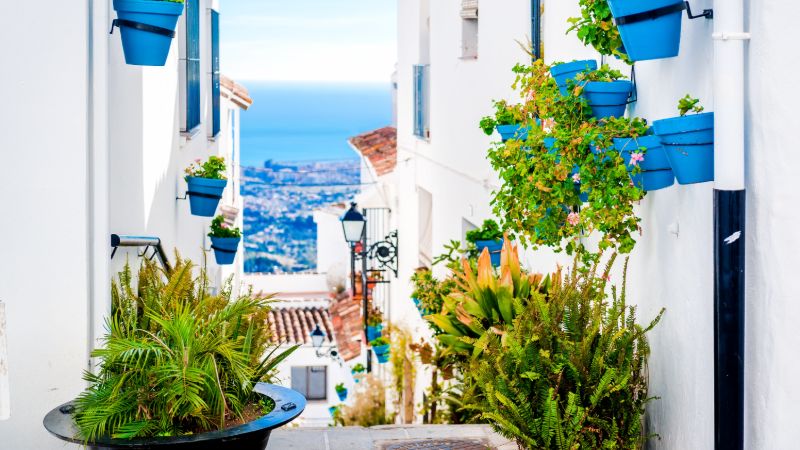
Mijas pueblo (village) is a short twenty minute drive from Malaga airport in Malaga province and is only fifteen minutes from the coast at La Cala de Mijas and Fuengirola.
Mijas is situated in the Sierra de Mijas mountains and is surrounded by beautiful pine forests. It has the best of both worlds with its white village charm, winding cobbled streets, breathtaking views and close proximity to the sea. If bullfighting is your thing, Mijas has its own bull ring which is still in use and is also used for horse displays. There is an auditorium which is used for concerts throughout the summer and there are also two museums to visit.
As well as being close to the coast, Mijas has its own fabulous infrastructure which includes shops and a wide and varied range of restaurants, all the usual supermarkets and other food shops and, perhaps best of all for the children a chocolate factory!
Special festivals in Mijas include Mijas International day which is a multicultural festival giving people from all over the world the opportunity to tell others about their culture and lifestyle, it is usually held in the first week in May. San Juan is celebrated on the night of the 23rd of June and is the celebration of the longest night of the year with festivities including dancing and fireworks. See our insider’s guide to Mijas.
Ronda
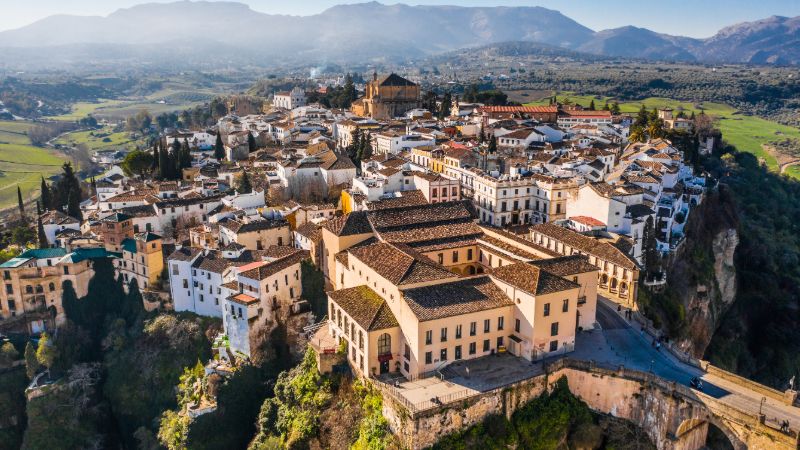
Ronda is in the Malaga province of Andalucía and is a one hour twenty minute drive from the airport at Malaga. It is situated north and inland of Marbella and Estepona.
The village of Ronda is third only to Seville and Granada in the most visited places in Andalucía. It is famous all over the world for being perched on the edge of the El Tajo gorge and offers fabulous views and countless photo opportunities. It is the modern birthplace of bullfighting and its bullring ‘Plaza de Toros’ is now a museum and attracts many thousands of visitors each year.
Ronda is accessible by road and rail, the drive to the village from the coast or from further inland is quite spectacular. There are two tourist offices here and a whole host of fabulous shops selling traditional, and not so traditional, Spanish crafts and other goods.
The ‘Fiesta de la Virgen de la Paz’ is the celebration of the patron Saint of Ronda and is held on the 24th of January every year. The feria is around the 20th of May and the main events of the year are held in the first week in September with the International Folklore Music and Dancing Festival and other festivities. See our Ronda guide here.
Viñuela
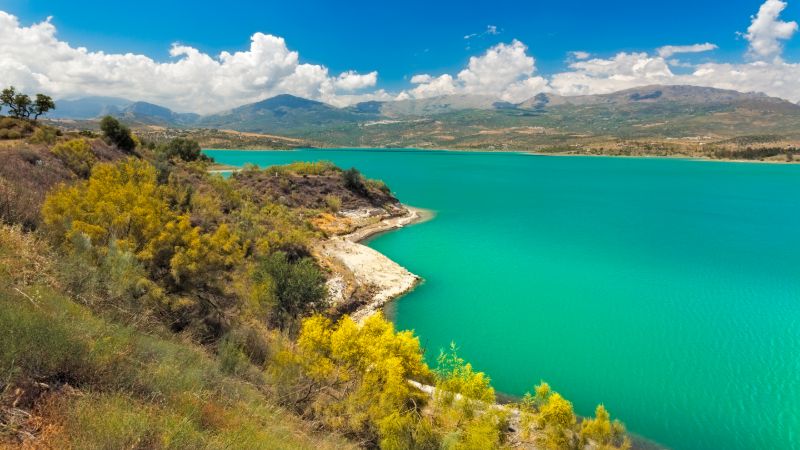
Viñuela is another white village in the Malaga province of Andalucía. It is inland of Velez Malaga, to the east of Malaga city, and is approximately fifty minutes from Malaga airport.
The stunning village of La Viñuela is set in the breathtaking landscape of the Axarquia and situated next to the man made reservoir of Lake Viñuela which provides the majority of drinking water for the local area. There are many luxury villas nestled in the hills with beautiful views over the lake and the lake itself boasts pretty beaches and non motorized water sports for all. There are picnic areas and barbecue areas all around the lake and the surrounding pine forests provide shade and a peaceful atmosphere for visitors.
La Viñuela was named after the local grape vines from which a delicious sweet wine is still produced today. The town is also famous for its local olive oil which is of particularly good quality. There are many arts and craft shops here including basket making and leather goods. There are also archeological sites in the village dating back to prehistoric, Roman and medieval times.
In May in La Viñuela there is a pilgrimage from the village to the hamlets of Los Gomez and Los Romanes for the Romeria which is a traditional gypsy festival. The annual feria is in mid July and there are three more ferias locally in early August, mid August and mid September.
Our readers would love to hear about your favourite white villages to visit from the Costa del Sol, just leave your comments below.
If you love the idea of exploring authentic Andalucia, then here are our top traditional Spanish villa recommendations from our Character Collection.
You might also like





